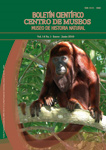Authors
Abstract
In the Valle del Cauca and Cauca departments in Colombia, three populations of red howler monkey were studied: two bamboo fragments (Nana Luisa Farm with 9.7 hectares, and the Montegrande municipal rural settlement with 60.3 hectares) and one area of continuous forests with forestry plantations and secondary forests (Cuenca del Nima). In 2004, population densities and group composition were evaluated using direct counts; additionally, information of the vegetation structure was collected. In the Nana Luisa Farm, a singlegroup of five individuals (51.5 indv/km2) was found. The structure and composition of the group, the total isolation and small size of the forest, indicates a decreasing population. This population is considered in danger. In the Montegrande municipal rural settlement had a population of 154 individuals and a high density of howlers (254.9 indv/km2). In this fragment, some groups tended to be numerous, probably due to the impossibility of dispersion of the young individuals (effect of the isolation). The plant diversity of this forest and the number of trees for howlers was low, suggesting a limited offer of resources. This population is considered vulnerable. The continuous forest presented a density of 22.6 individuals/km2, this value and the composition of the howler groups are similar to those usually reported for the species (in spite of the small sample size). This population is considered “healthy”.
References
ARROYO-RODRÍGUEZ, V.; MANDUJANO, S.; BENÍTEZ-MALVIDO, J. & CUENDE-FANTON, C., 2007. The Influence of large tree density on howler monkey (Alouatta palliata mexicana) presence in very small rain forest fragments. Biotropica, 39 (6): 760-766.
BALDWIN, J. & BALDWIN, J., 1972. Population density and use of space in howling monkeys (Alouatta villosa) in southwestern Panamá. Primates, 13 (4): 371-379.
BICCA-MARQUES, J.C., 2003. How do the howlers cope with habitat fragmentation?: 283-304 (en) MARSH, K. L. (ed.) Primates in fragments: ecology and conservation. Kluwer Academic / Plenum Publisher, New York.
CHAPMAN, C. & BALCOMB, S., 1998. Population characteristics of howlers: ecological conditions or group history. Int. J. Primatol., 19: 385-403.
CROCKETT, C., 1996. The relation between red howler monkey (Alouatta seniculus) troop size and population growth in two habitats: 489-510 (en) NORCONK, M.A.; ROSENBERG, A.L. & GARBER, P.A. (eds.) Adaptive Radiations of Neotropical Primates. Plenum Press, New York.
________., 1998. Conservation biology of the genus Alouatta. Int. J. Primatol., 19 (3): 549-578.
CROCKETT, C. & EISENBERG, J., 1987. Howlers: variations in group size and demography: 54-68 (en) SMUTS, B.; CHENEY, D.; SEYFARTH, R.; WRANGHAM R. & STRUHSAKER T. (eds.) Primate Societies. The University of Chicago Press, Chicago.
DEFLER, T., 1981. The density of Alouatta seniculus in the Eastern Llanos of Colombia. Primates, 22 (4): 564-569.
________., 2004. Primates of Colombia. Tropical Field Series 5. Conservation International, Bogotá.
ESTRADA, A. & COATES-ESTRADA, R., 1996. Tropical rain forest fragmentation and wild populations of primates at los Tuxtlas, Mexico. Int. J. Primatol., 17 (5): 759-781.
ESTRADA, A.; MENDOZA, A.; CASTELLANOS, L.; PACHECO, R.; VAN BELLE, S.; GARCÍA, Y. & MUÑOZ, D., 2002. Population of black howler monkey (Alouatta pigra) in a fragmented landscape in Palenque, Chiapas, Mexico. Am. J. Primatol., 58: 45-55.
GAULIN, S. & GAULIN, C., 1982. Behavioral ecology of Alouatta seniculus in Andean cloud forest. Int. J. Primatol., 3: 1-32.
GÓMEZ-POSADA, C.; GIRALDO-CHAVARRIAGA, P. & ÁLVAREZ, Z., 2009. Densidad y estatus poblacional de mono aullador rojo en un guadual, fragmento aislado, Quindío, Colombia. Universitas Scientiarium, 14 (1): 8-15.
GÓMEZ-POSADA, C. & LONDOÑO, J. M., 2007. Evaluación del estado de la población del mono aullador rojo (Alouatta seniculus) en la Reserva La Montaña del Ocaso. Manuscrito no publicado. CIBUQ, Universidad del Quindío. Fundación Ecoandina / WCS Colombia, Cali.
GÓMEZ-POSADA, C.; MARTÍNEZ, J.; GIRALDO, P. & KATTAN, G.H., 2007. Density, habitat use, and ranging patterns of Red Howler Monkeys in a Colombian Andean Forest. Neotrop. Primates, 14 (1): 2-10.
GÓMEZ-POSADA, C.; RONCANCIO, N. & HINCAPIÉ, P., 2005. Evaluación de la densidad poblacional del mono aullador rojo en fragmentos de bosque en el departamento del Valle del Cauca. Manuscrito no publicado. Corporación Regional del Valle del Cauca. Fundación Ecoandina /WCS Programa Colombia, Cali.
HERNÁNDEZ-CAMACHO, J. & COOPER, R., 1976. The nonhuman primates of Colombia: 35-69 (en) THORINGTON R. & HELTNE P.G. (eds.) Neotropical primates: field studies and conservation. National Academy of Sciences, Washington D.C.
HELTNE, P.; TURNER, D. & SCOTT N., 1976. Comparison of census on Alouatta palliata from Costa Rica and Panamá: 10-19 (en) THORINGTON, R.W.JR. & HELTNE P.G. (eds.) Neotrop. Primates: Field Studies and Conservation. National Academy of Sciences, Washington D.C.
HORWICH, R., 1998. Effective solution for howler conservation. Int. J. Primatol., 19 (3): 579-598.
IZAWA, K., 1988. Preliminary reports on social changes on red howlers (Alouatta seniculus): 29-33 (en) Field Studies of New World Monkeys. La Macarena, Colombia.
KATTAN, G., 1998. Transformación de paisajes y fragmentación de hábitat: 76-82 (en) CHÁVEZ M. & ARANGO N. (eds.) Informe Nacional sobre el estado de la Biodiversidad. Tomo 2: Causas de pérdida de biodiversidad. Instituto Alexander von Humboldt, Santa Fe de Bogotá.
________., 2002. Fragmentación: patrones y mecanismos de extinción de especies: 561-590 (en) M.R. GUARIGUATA & G.H. KATTAN (eds.) Ecología y conservación de bosques neotropicales. Libro Universitario Regional, Cartago, Costa Rica.
MILTON, K., 1980. The foraging strategy of howler monkeys. A study in primate economics. Columbia University Press, New York.
NEVILLE, M., 1972. The population structure of red howler monkeys (Alouatta seniculus) in Trinidad and Venezuela. Folia Primatol., 17: 56-86.
OSTRO, L.E.; SILVER, S.; KOONTZ, F.W.; HORWICH, R. & BROCKETT, R., 2001. Shifts in social structure of Black Howler (Alouatta pigra) groups associated with natural and experimental variation in population density. Int. J. Primatol., 22 (5): 733-748.
PETTO, A.; CAICEDO, R.; MEDINA, A.; MEDINA, L.; CAICEDO, E. & DUQUE, F., 1991. Sistemas de información geográfica de la Unidad de Manejo de la Cuenca Amaime-Nima-El Cerrito. Corporación Regional del Valle del Cauca, Cali.
PINTO, L.; COSTA, C.; STRIER, K. & FONSECA, G., 1993. Habitat, density and group size of primates in brazilian tropical forest. Folia Primatol., 61: 135-143.
RYLANDS, A. & KEUROGHLIAN, A., 1988. Primate populations in continuous forest and forest fragments in central Amazonia. Acta Amazónica, 18 (3-4): 291-307.
SCHWARZKOPF, L. & RYLANDS, A., 1989. Primate species richness in relation to habitat structure in Amazonian rainforest fragments. Biological Conservation, 48: 1-12.
SOINI, P., 1992. Ecología del coto mono (Alouatta seniculus, CEBIDAE) en el río Pacaya, reserva Pacaya - Saimiria, Perú. Folia Amazónica, 4 (2): 103-118.
VAN BELLE, S. & ESTRADA, A., 2005. Cambios demográficos en poblaciones del mono aullador negro (Alouatta pigra) como consecuencia de la fragmentación del hábitat. Universidad y Ciencia, Número Especial 002: 1-9.

 PDF (Español)
PDF (Español)
 FLIP
FLIP


















